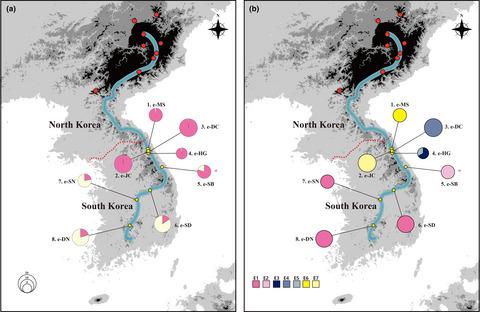当前位置:
X-MOL 学术
›
Ecol. Evol.
›
论文详情
Our official English website, www.x-mol.net, welcomes your
feedback! (Note: you will need to create a separate account there.)
Rear‐edge, low‐diversity, and haplotypic uniformity in cold‐adapted Bupleurum euphorbioides interglacial refugia populations
Ecology and Evolution ( IF 2.3 ) Pub Date : 2020-08-24 , DOI: 10.1002/ece3.6700 Won-Bum Cho 1 , Soonku So 2 , Eun-Kyeong Han 3 , Hyeon-Ho Myeong 2 , Jong-Soo Park 4 , Seung-Hyun Hwang 5 , Joo-Hwan Kim 6 , Jung-Hyun Lee 1
Ecology and Evolution ( IF 2.3 ) Pub Date : 2020-08-24 , DOI: 10.1002/ece3.6700 Won-Bum Cho 1 , Soonku So 2 , Eun-Kyeong Han 3 , Hyeon-Ho Myeong 2 , Jong-Soo Park 4 , Seung-Hyun Hwang 5 , Joo-Hwan Kim 6 , Jung-Hyun Lee 1
Affiliation

|
The high genetic diversity of rear‐edge refugia populations is predicted to have resulted from species repeatedly migrating to low latitudes during glacial periods over the course of Quaternary climate change. However, several recent empirical studies of cold‐tolerant plants revealed the opposite pattern. We investigated whether current habitats of the cold‐adapted and range‐restricted Bupleurum euphorbioides in the Baekdudaegan, South Korea, and North Korea could be interglacial refugia, and documented how their rear‐edge populations differ genetically from those of typical temperate species. Phylogeographic analysis and ecological niche modeling (ENM) were used. The genetic structure was analyzed using microsatellite markers and chloroplast DNA sequences. The congener B. longiradiatum was included as a typical temperate plant species. Despite having almost identical life history traits, these congeneric species exhibited contrasting patterns of genetic diversity. ENM revealed an apparent maximum range contraction during the last interglacial. In contrast, its range expanded northward to the Russian Far East (Primorsky) during the Last Glacial Maximum. Thus, we hypothesize that B. euphorbioides retreated to its current refugia during interglacial periods. Unlike populations in the central region, the rear‐edge populations were genetically impoverished and uniform, both within populations and in pooled regional populations. The rear‐edge B. euphorbioides survived at least one past interglacial, contributing to the species’ genetic diversity. We believe that such genetic variation in the cold‐adapted B. euphorbioides gives the species the necessary adaptations to survive an upcoming favorable environment (the next glacial), unless there is artificial environmental change.
中文翻译:

冷适应大戟间冰期栖息地种群的后缘、低多样性和单倍型一致性
据预测,后缘保护区种群的高遗传多样性是由于第四纪气候变化过程中冰川时期物种反复迁徙到低纬度地区造成的。然而,最近的几项耐寒植物的实证研究揭示了相反的模式。我们调查了白头大干、韩国和朝鲜的适应寒冷和范围受限的大戟柴当前的栖息地是否可能是间冰期避难所,并记录了它们的后缘种群与典型温带物种的遗传差异。使用系统发育地理学分析和生态位模型(ENM)。使用微卫星标记和叶绿体 DNA 序列分析遗传结构。同源B. longiradiatum被列为典型的温带植物物种。尽管具有几乎相同的生活史特征,这些同属物种却表现出截然不同的遗传多样性模式。ENM 揭示了末次间冰期期间明显的最大范围收缩。相比之下,在末次盛冰期,其活动范围向北扩展至俄罗斯远东地区(滨海边疆区)。因此,我们假设大戟在间冰期退缩到目前的栖息地。与中部地区的人口不同,无论是在人口内部还是在区域总人口中,后缘人口的基因贫乏且均一。后缘的大戟B. euphorbioides至少在过去的一次间冰期中幸存下来,为该物种的遗传多样性做出了贡献。我们相信,适应寒冷的大戟的这种遗传变异赋予了该物种必要的适应能力,以便在即将到来的有利环境(下一次冰川)中生存,除非存在人为环境变化。
更新日期:2020-10-12
中文翻译:

冷适应大戟间冰期栖息地种群的后缘、低多样性和单倍型一致性
据预测,后缘保护区种群的高遗传多样性是由于第四纪气候变化过程中冰川时期物种反复迁徙到低纬度地区造成的。然而,最近的几项耐寒植物的实证研究揭示了相反的模式。我们调查了白头大干、韩国和朝鲜的适应寒冷和范围受限的大戟柴当前的栖息地是否可能是间冰期避难所,并记录了它们的后缘种群与典型温带物种的遗传差异。使用系统发育地理学分析和生态位模型(ENM)。使用微卫星标记和叶绿体 DNA 序列分析遗传结构。同源B. longiradiatum被列为典型的温带植物物种。尽管具有几乎相同的生活史特征,这些同属物种却表现出截然不同的遗传多样性模式。ENM 揭示了末次间冰期期间明显的最大范围收缩。相比之下,在末次盛冰期,其活动范围向北扩展至俄罗斯远东地区(滨海边疆区)。因此,我们假设大戟在间冰期退缩到目前的栖息地。与中部地区的人口不同,无论是在人口内部还是在区域总人口中,后缘人口的基因贫乏且均一。后缘的大戟B. euphorbioides至少在过去的一次间冰期中幸存下来,为该物种的遗传多样性做出了贡献。我们相信,适应寒冷的大戟的这种遗传变异赋予了该物种必要的适应能力,以便在即将到来的有利环境(下一次冰川)中生存,除非存在人为环境变化。











































 京公网安备 11010802027423号
京公网安备 11010802027423号